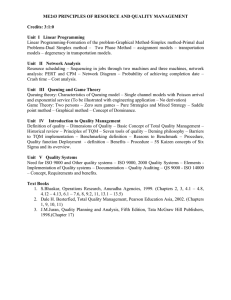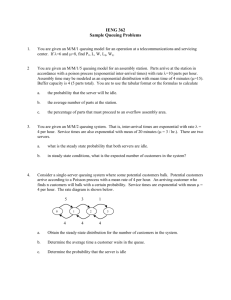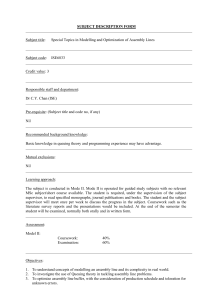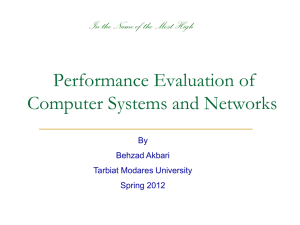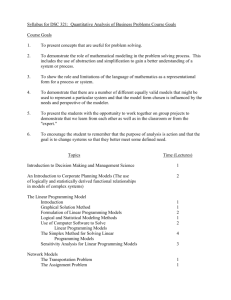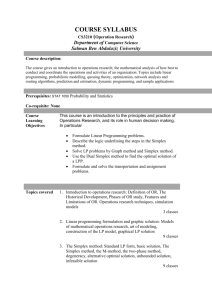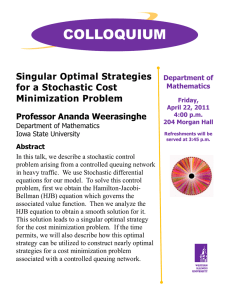On Two Modifications of E /E m System Subject to Disasters
advertisement
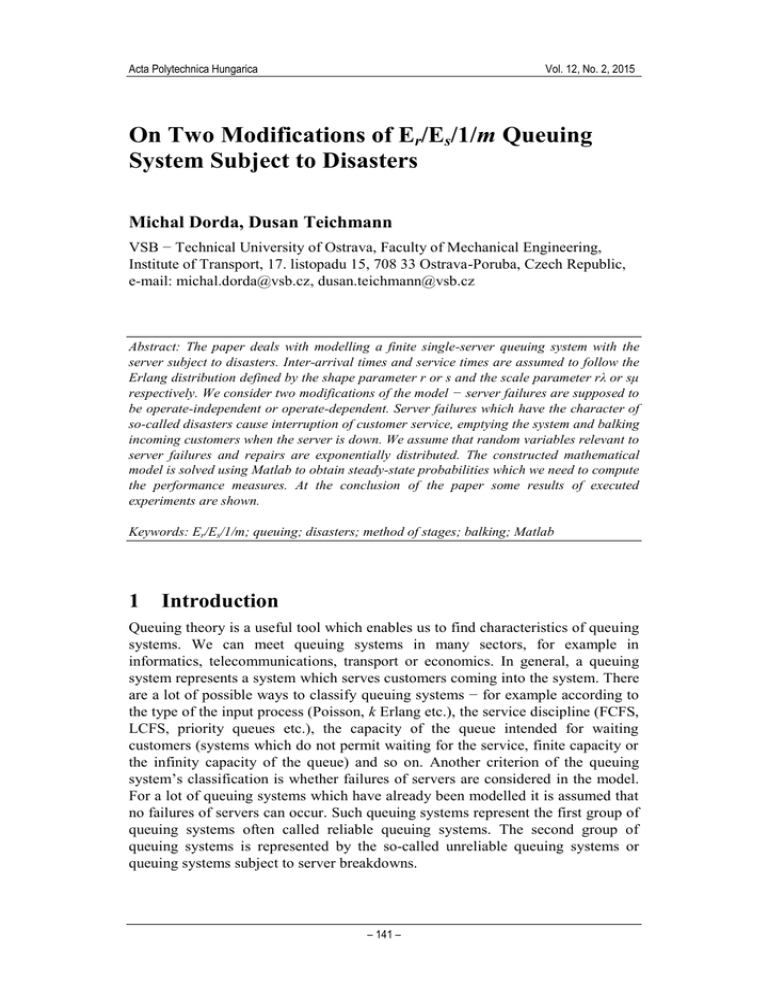
Acta Polytechnica Hungarica
Vol. 12, No. 2, 2015
On Two Modifications of Er/Es/1/m Queuing
System Subject to Disasters
Michal Dorda, Dusan Teichmann
VSB − Technical University of Ostrava, Faculty of Mechanical Engineering,
Institute of Transport, 17. listopadu 15, 708 33 Ostrava-Poruba, Czech Republic,
e-mail: michal.dorda@vsb.cz, dusan.teichmann@vsb.cz
Abstract: The paper deals with modelling a finite single-server queuing system with the
server subject to disasters. Inter-arrival times and service times are assumed to follow the
Erlang distribution defined by the shape parameter r or s and the scale parameter rλ or sμ
respectively. We consider two modifications of the model − server failures are supposed to
be operate-independent or operate-dependent. Server failures which have the character of
so-called disasters cause interruption of customer service, emptying the system and balking
incoming customers when the server is down. We assume that random variables relevant to
server failures and repairs are exponentially distributed. The constructed mathematical
model is solved using Matlab to obtain steady-state probabilities which we need to compute
the performance measures. At the conclusion of the paper some results of executed
experiments are shown.
Keywords: Er/Es/1/m; queuing; disasters; method of stages; balking; Matlab
1
Introduction
Queuing theory is a useful tool which enables us to find characteristics of queuing
systems. We can meet queuing systems in many sectors, for example in
informatics, telecommunications, transport or economics. In general, a queuing
system represents a system which serves customers coming into the system. There
are a lot of possible ways to classify queuing systems − for example according to
the type of the input process (Poisson, k Erlang etc.), the service discipline (FCFS,
LCFS, priority queues etc.), the capacity of the queue intended for waiting
customers (systems which do not permit waiting for the service, finite capacity or
the infinity capacity of the queue) and so on. Another criterion of the queuing
system’s classification is whether failures of servers are considered in the model.
For a lot of queuing systems which have already been modelled it is assumed that
no failures of servers can occur. Such queuing systems represent the first group of
queuing systems often called reliable queuing systems. The second group of
queuing systems is represented by the so-called unreliable queuing systems or
queuing systems subject to server breakdowns.
– 141 –
M. Dorda et al.
On Two Modifications of Er/Es/1/m Queuing System Subject to Disasters
Failures of the server have an obvious impact on the performance measures of the
studied queuing system. It is clear, for example, that the mean number of the
customers in the service for an unreliable queuing system should be less than the
value of the same performance measure for a corresponding queuing system
which is not subject to breakdowns. A lot of policies have been developed; the
policies determine what happens with the customer being served when the server
breaks down. In this paper we consider that failures of the server cause emptying
of the queuing system; meaning that all customers in the system leave it without
being served. Moreover, each customer coming into the system when the server is
broken down is not willing to wait and leaves the system (or is rejected). Such
type of server failures are often called disasters or catastrophes.
Some authors have already modelled queuing systems with server failures having
the character of disasters or catastrophes. Krishna Kumar et al. [1] solved an
M/M/1 queuing system. Catastrophes of the server occur according to the Poisson
process when the server is busy. Whenever a catastrophe occurs the system
empties instantly and all newly arriving customers are lost during the server
repair. Sudhesh [2] studied a similar M/M/1 queue which differs in the fact that
customers entering the system become impatient when the server is down. The
authors of papers [1] and [2] executed transient analysis of the systems, which
means they derived formulas for system state probabilities as functions of the time
t. Yechiali [3] examined an M/M/c queue with random disastrous failures which
cause all present customers to be lost. Customers entering the system during
repairing of the server are considered to be impatient.
Queuing systems in which inter-arrival and service times are considered to follow
the Erlang distribution have already been studied in the past. But in comparison
with queues assuming exponential or general distributed inter-arrival and service
times, the models of queuing systems under the assumption of the Erlang
distribution are not so common, especially in the case of being subject to
breakdowns.
Let us look at some models of reliable queuing systems in which the Erlang
distribution is assumed. Plumchitchom and Thomopoulos [4] studied a singleserver queuing system with Erlang distributed inter-arrival and service times.
Wang and Huang [5] modelled a finite M/E k/1 queuing system with a removable
server (the server is turned off and turned on depending on the number of
customers in the system). The authors further presented a cost function to
determine the optimal policy. Cost and profit analysis for an M/E k/1 queuing
system with removable service station was carried out by Mishra and
KumarYadav [6]. Yu et al. [7] developed a model of an M/E k/1 queuing system
with no damage service interruptions − it is assumed that after the first phase of
service the service process can be interrupted with given probability. Binkowski
and McCarragher [8] employed an Er/Ek/1/N queuing system to model the
operation of a mining stockyard. An optimal management problem of the N-policy
M/Ek/1 queuing system with a removable service station under steady-state
– 142 –
Acta Polytechnica Hungarica
Vol. 12, No. 2, 2015
condition was solved by Pearn and Chang [9]. In the paper [10] written by ElPaoumy and Ismail a solution of a finite MX/Ek/1/N with bulk arrivals, balking and
reneging is demonstrated. The matrix-geometric solution of the M/Ek/1 queue with
balking and state-dependent service was demonstrated by Yue et al. [11]. Shawky
[12] considered a single-channel service time Erlangian queue with finite source
of customers, one server, finite storage capacity and balking and reneging. Adan et
al. [13] analysed an Ek/Er/c queuing system.
Some authors solved queues subject to failures under the assumption of the Erlang
distribution which was most often applied to model service times. An M/E k/1
queue with server vacation was studied by Jain and Agrawal [14]. The authors
further assumed that the server can break down when it is busy and the Poisson
arrival rate is state dependent. Wang and Kuo [15] solved an M/Ek/1 machine
repair problem − several identical machines operating under the care of an
unreliable service station. The authors employed matrix geometric method to
derive the steady-state probabilities and developed the steady-state profit function
to find out the optimum number of machines. Kumar et al. [16] considered an
MX/Ek/1 two-phase queuing system with a single removable server and with
gating, server start-up and unpredictable breakdowns.
In this paper we will focus on finite single-server queuing systems with the server
subject to disasters, where inter-arrival times and service times follow Erlang
distribution. Further we will assume that times between failures and times to
repair are exponentially distributed. We employed a “direct” approach to model
the queuing systems consisting of creating a state transition diagram, on the basis
of the diagram we derive a linear equation system describing the system and the
equation system is solved numerically using suitable software; in the paper we
give a hint for solving in Matlab [17]. We hope that this paper makes the solving
of finite Erlang distributed queuing systems possible primarily to nonmathematicians who are not able to employ the most advanced mathematical
methods used for analytical solving of queuing systems.
The rest of the paper is organized as follows. In Section 2 we will discuss the
necessary assumptions. In Section 3 we will present the mathematical model and
its solving using Matlab. In Section 4 we will present results of some numerical
experiments we did with the proposed model. Please note that the paper is an
extended version of our conference paper presented at the conference
Mathematical Methods in Economics 2012 [18].
2
General Assumptions and Notations
Let us consider a single-server queuing system with a finite capacity equal to m,
where m>1; that means the system has the capacity of m places for customers −
single place in the service and m−1 places intended for the waiting of customers.
– 143 –
M. Dorda et al.
On Two Modifications of Er/Es/1/m Queuing System Subject to Disasters
Customers waiting in the queue are served one by one according to the FCFS
service discipline.
Let inter-arrival times follow the Erlang distribution with the shape parameter r≥2
and the scale parameter rλ; therefore the mean inter-arrival time is then equal to
r
1
. Service times are also Erlang distributed with the shape parameter s≥2
r
s
1
and the scale parameter sμ; thus the mean service time is equal to
. We
s
apply the Erlang distribution because it is able to model time duration of a lot of
practical processes in comparison with the exponential distribution, which is often
used. On the other hand, using the Erlang distribution brings some complications
in modelling the system. However, single-server queues with the Erlang
distribution of inter-arrival times or service times are still solvable using
conventional methods.
Let us assume that the server is successively failure-free (or available) and under
repair. We will assume two modifications. For the first modification we consider
that failures of the server can occur when the server is idle or busy − we say that
server failures are operate-independent. In the case of the second modification we
assume that failures of the server are so-called operate-dependent, which means
the server can break down only when it is servicing a customer. Let us assume for
both modifications that repair of the server is started immediately after
breakdowns, and it immediately starts to operate when repaired.
Now it is necessary to make some assumptions about failure frequency. Due to the
fact that our modifications differ in assumptions about the occurrence of server
failures we have to make different suppositions for individual modifications of the
studied system. Assuming ergodicity (the system has the finite capacity), all of the
possible states of the system can be summarized into three states:
The idle state − no customer is in the system (the system is empty) and
the server is not broken down (is in working condition). Let us denote the
equilibrium probability that the server is idle Pidle.
The busy state − i customers are in the system, where i 1,...,m ; that
means a customer is in the service and (i−1) customers are waiting in the
queue. The equilibrium probability that the system is found in the busy
state is denoted with Pbusy.
The down state − no customer is in the system (as we are considering
disasters) and the server is broken down and under repair; let us denote
the equilibrium probability of this state Pdown.
As these states are mutually exclusive and exhaustive, the sum of these
probabilities has to be equal to 1:
Pidle Pbusy Pdown 1 .
(1)
– 144 –
Acta Polytechnica Hungarica
Vol. 12, No. 2, 2015
Let us start with the first modification. The server is successively available and
broken down. Let the times the server is available be exponentially distributed
with the parameter η meaning that the mean time the server is available equals the
reciprocal value of the parameter η. Times to repair are exponentially distributed
1
as well, but with the parameter ζ; the mean time to repair therefore equals to . It
is clear that the server’s steady-state availability A (the ratio of time the server is
available in expected value) is equal to:
1
A
1
1
Pidle Pbusy
(2)
and the server’s steady-state unavailability U (the ratio of time the server is broken
down in expected value) is:
U 1 A
Pdown .
(3)
And now we have to use similar assumptions about the second modification. Let
us assume that times of overall server working between failures are exponentially
distributed with the parameter η; the mean time of overall server working between
failures is then equal to the reciprocal value of the parameter η. Times to repair are
exponentially distributed as well, but with the parameter ζ; the mean time to repair
1
is therefore equal to
as well.
To express the server’s steady-state availability it is necessary to realize that in
this modification the server failures are not as frequent as in the first modification
for the same value of the parameter η. The value η has to be multiplied by a
P P
coefficient expressed by ratio idle busy which takes into account the fact that
Pbusy
the ratio of time the server is idle has no impact on failure frequency. Now, for the
server’s steady-state availability we can write:
Pidle Pbusy 1
Pbusy
Pidle Pbusy
A
Pidle Pbusy .
Pidle Pbusy 1 1 Pbusy Pidle Pbusy
Pbusy
(4)
Realizing that Pdown 1 Pidle Pbusy and substituting it into (4) we can derive an
expected formula in the form:
Pdown
Pbusy U .
(5)
– 145 –
M. Dorda et al.
On Two Modifications of Er/Es/1/m Queuing System Subject to Disasters
As far as the behaviour of customers at the moment of the failure is concerned, we
will assume that the system empties after every breakdown of the server; and the
system is empty when the server is down − i.e. failures represent so-called
disasters (or catastrophes) in the system.
Let us mention an example of such queuing system from railway transport.
Marshalling yards represent important nodes on each railway net because they
carry out inbound freight trains classification according to directions of individual
wagons and form new outbound freight trains. Such yards are usually equipped
with corresponding infrastructure consisting of reception sidings, a hump, sorting
sidings and so on. The process of freight trains classification is carried out via the
hump − a train of wagons is shunted from an arrival track over the hump and
individual wagons (or set of wagons) are classified onto sorting sidings according
to their directions.
The hump can be considered to be the server, the inbound freight trains represent
customers and the classification process is their service. However, the
infrastructure belonging to the hump can break down from time to time. For
example, some switches of the ladder below the hump can be broken down so
wagons cannot be classified over the hump. In such cases we must carry out the
classification process in a different way without using the hump.
Another example of such queuing system could be a gas station that is open nonstop. The station is equipped with one gas pump. Drivers arrive at the gas station
in order to pump and pay. However, the gas station is a technical device so it can
be subject to breakdowns. Because the gas station has only one gas pump, no
driver can be served and therefore drivers do not arrive at the station when the gas
pump is closed (under repair). Also all drivers who are at the station when the gas
pump breaks down leave the station to pump somewhere else.
As we stated before, the failures of the server have an impact on performance
measures, therefore it is important to incorporate the failures in mathematical
models of such queuing systems in order to get non-biased results.
3
Mathematical Model
To model the studied queuing system we applied the method of stages (see for
example Kleinrock [19]). The method utilizes the fact that the Erlang distribution
with the shape parameter r or s and the scale parameter rλ or sμ is a sum of r or s
independent exponential distributions with the same parameter rλ or sμ. The
process of each customer’s arrival consists of r exponential phases and the
customer enters the system (or is rejected when the system is full) after finishing
the last phase. Analogously, the service of each customer consists of s exponential
phases and the customer leaves the system after finishing the last phase. Because
the duration of all phases is exponentially distributed, the queue can be modelled
– 146 –
Acta Polytechnica Hungarica
Vol. 12, No. 2, 2015
by a Markov chain. The reason for using the Erlang distribution is that this
distribution is more general than the exponential distribution, which cannot be
used in many practical examples; the Erlang distribution can be used to model
random variables with a coefficient of variation less than 1.
Let us consider a random variable K(t) being the number of the customers found
in the system, a random variable I(t) being the number of finished phases of
customer’s arrival, a random variable J(t) being the number of finished phases of
customer’s service and a random variable F(t) being the number of broken servers
at the time t. On the basis of the assumptions established in Section 2 it is clear
that {K(t), I(t), J(t), F(t)} constitutes a Markov chain with the state space
k , i, j, f , k 0, i 0,...,r 1, j 0, f 0,1
k , i, j, f , k 1,...,m, i 0,...,r 1, j 0,...,s 1, f 0.
Let us note that the first subset contains all the idle and down states and the
second subset the busy states. The system is found in the state (k,i,j,f) at the time t
if K(t)=k, I(t)=i, J(t)=j and F(t)=f; let us denote the corresponding probability
P(k,i,j,f)(t). Complex information about Markov chains can be found for example in
Bolch et al. [20].
Now we would like to set up the mathematical model of the system. At first, let us
establish a group of variables αk, where k=0,1,...,m. The variable αk for k=0,1,...,m
can take its value from the set {0,1}. The variables enable us to create the general
model for both modifications (we can even create other modifications of the
studied system using the variables, for example a modification in which the server
breaks down only when the system is full). The variables will be used as a
multiplier of the failure rate η. For the first modification we have αk=1 for
k=0,1,...,m; that means the server can break down when idle (k=0) or busy
(k=1,...,m). For the second modification we have α0=0 (the server can not break
down when idle) and αk=1 for k=1,...,m (the server can break down when busy).
Now we can illustrate the queuing model graphically on a state transition diagram
(Figure 1). The vertices represent the particular states of the system and the
directed edges indicate the possible transitions with the corresponding rates.
Please note that in Figure 1 only those states are depicted which are necessary for
the formation of an equation system. Due to the fact that some edges lead from
nowhere or point to nowhere in Figure 1, let us comment on such examples:
The all red edges should point to states (0,0,0,1) up to (0,r−1,0,1) (the
down states). But we did not draw all of them to these states because it
would make the diagram more chaotic.
Some green and blue edges are duplicated because the states to which the
edges point or from which they lead are not depicted in Figure 1. For
example, the green edge exiting the state (0,0,0,0) leads to the state
(0,1,0,0), which is not depicted in Figure 1. On the other hand, the green
edge leading to the state (0,i,0,0) exits the state (0,i−1,0,0), which is not
– 147 –
M. Dorda et al.
On Two Modifications of Er/Es/1/m Queuing System Subject to Disasters
depicted either. The blue edge exiting the state (1,0,0,0) leads to the state
(1,0,1,0) (not depicted) and the blue edge leading to the state (1,0,j,0)
exits the state (1,0,j−1,0) (not depicted too).
Some diagonal green edges lead from nowhere or point to nowhere for
the same reason. For example the green edge exiting the state (1,r−1,0,0)
leads to the state (2,0,0,0) (not depicted) and the green arc leading to the
state (k,0,0,0) exits the state (k−1,r−1,0,0) (not depicted).
Figure 1
The state transition diagram
– 148 –
Acta Polytechnica Hungarica
Vol. 12, No. 2, 2015
An original file containing the diagram can be downloaded from a web-page with
the supplementary material − see [21].
Now we apply the global balance principle, which states that for each set of states
X the flow out of the set X is equal to the flow into the set X (see Adan and
Resing [22]). On the basis of the state transition diagram we are able to write the
finite linear equation system of the steady-state balance equations in the form:
r 0 P0,0,0,0 s P1,0, s 1,0 P0,0,0,1 ,
(6)
for i 1,...,r 1 :
r 0 P0,i,0,0 r P0,i 1,0,0 s P1,i, s 1,0 P0,i,0,1 ,
(7)
for k 1,...,m 1 :
r s k Pk ,0,0,0 r Pk 1,r 1,0,0 s Pk 1,0, s 1,0 ,
(8)
for k 1,...,m 1, i 1,...,r 1 :
r s k Pk ,i,0,0 r Pk ,i 1,0,0 s Pk 1,i, s 1,0 ,
(9)
for j 1,...,s 1 :
r s 1 P1,0, j ,0 s P1,0, j 1,0 ,
(10)
for k 1,...,m, i 1,...,r 1, j 1,...,s 1 :
r s k Pk ,i, j ,0 r Pk ,i 1, j ,0 s Pk ,i, j 1,0 ,
(11)
for k 2,...,m 1, j 1,...,s 1 :
r s k Pk ,0, j ,0 r Pk 1,r 1, j ,0 s Pk ,0, j 1,0 ,
(12)
r s m Pm,0,0,0 r Pm1,r 1,0,0 r Pm,r 1,0,0 ,
(13)
for j 1,...,s 1 :
r s m Pm,0, j ,0 r Pm1,r 1, j ,0 r Pm,r 1, j ,0 s Pm,0, j 1,0 ,
(14)
for i 1,...,r 1 :
r s m Pm,i,0,0 r Pm,i 1,0,0 ,
(15)
m s 1
r P0,0,0,1 r P0,r 1,0,1 0 P0,0,0,0 k Pk ,0, j ,0 ,
(16)
k 1 j 0
for i 1,...,r 1 :
m s 1
r P0,i,0,1 r P0,i 1,0,1 0 P0,i,0,0 k Pk ,i, j ,0 .
k 1 j 0
– 149 –
(17)
M. Dorda et al.
On Two Modifications of Er/Es/1/m Queuing System Subject to Disasters
Subtracting the probability on the left side of each equation (6) − (17) we got an
equation system which can be written in the matrix form:
0 QT P ,
where QT is the transposed infinitesimal generator matrix containing the transition
rates of the Markov process and P is the unknown steady-state probability vector.
Because the matrix QT is singular (the equation set is not linearly independent and
one equation is redundant), it is necessary to incorporate the normalization
condition in the form:
r 1 1
m r 1 s 1
P0,i ,0, f Pk ,i , j ,0 1 .
i 0 f 0
3.1
(18)
k 1 i 0 j 0
Solving Equation System using Matlab and Performance
Measures
We got the equation system of m r s 2r 1 linear equations formed by
equations (6) up to (18). The number of the unknown stationary probabilities is
equal to m r s 2r .
To solve the corresponding equation system we can omit an equation, for example
equation (6). Numerical solving of the system can be performed using Matlab.
However, the applied state description in the form of (k,i,j,f) is four-dimensional
and is very good for the formation of the equation system but is absolutely
unsuitable for the computations in Matlab. Therefore we are obliged to establish
an alternative one-dimensional state description in the following form:
The states (k,i,j,f) for k=1,...,m, i=0,...,r−1, j=0,...,s−1 and f=0 can be
denoted using a single value k 1 r s j r i 1 ,
The states (k,i,j,f) for k=0, i=0,...,r−1, j=0 and f=0,1 can be denoted using
a single value m r s f r i 1 .
Applying the alternative one-dimensional state description we are able to
transform the equation system in the form we need for using Matlab (we have to
work with matrices). In Matlab we solve the linear system in the form:
B AP ,
where B 0;...;1;...;0 , where the value 1 is in the row m r s 1 (in the case
that we omit the equation corresponding to the steady-state probability P0,0,0,0 ), A
T
we get from the matrix QT in which the row m r s 1 is substituted by the row
matrix 1;1;....;1 and P is the unknown steady-state probability vector.
– 150 –
Acta Polytechnica Hungarica
Vol. 12, No. 2, 2015
After numerical solving of the equation system rewritten in the matrix form we
obtain the stationary probabilities we need in order to compute performance
measures of the studied system.
On the basis of the known stationary probability vector P, the steady-state
probability that the server is idle is equal to:
r 1
Pidle P0,i ,0,0 ,
(19)
i 0
the steady-state probability that the server is busy can be expressed by the
formula:
m r 1 s 1
Pbusy Pk ,i , j ,0
(20)
k 1 i 0 j 0
and for the equilibrium probability that the server is down it holds:
r 1
Pdown P0,i ,0,1 .
(21)
i 0
Now let us consider three performance measures − the mean number of the
customers in the service ES, the mean number of the customers waiting in the
queue EL and the mean number of the broken servers EF. All of them can be
computed according to the formula for the mean value of discrete random
variable, where the random variable S 0,1 is the number of customers in the
service, L 0, m 1 the number of waiting customers and F 0,1 the number
of broken servers.
For the performance measures we can write following formulas:
ES Pbusy ,
(22)
m
r 1 s 1
k 2
i 0 j 0
EL k 1 Pk ,i , j ,0 ,
(23)
EF Pdown .
(24)
The Matlab script (m.file) with defined function enabling computation of
equilibrium probabilities (19), (20) and (21) and performance measures (22), (23)
and (24) is published online − see [21].
– 151 –
M. Dorda et al.
4
On Two Modifications of Er/Es/1/m Queuing System Subject to Disasters
Results of Experiments
We performed several experiments with both modifications to demonstrate
solvability of the presented model and to obtain some graphical dependencies.
Applied values of the model parameters are summarized in Table 1.
Table 1
Summary of applied values of the model parameters
Parameter
m [-]
r [-]
rλ
[h-1]
s [-]
sμ
[h-1]
η [h-1]
ζ [h-1]
Value
5
2
18
2
20
0.01 up to 0.1
with step 0.01
0.1 up to 1.0 with
step 0.1
Substituting the values summarized in Table 1 into the model rewritten in Matlab
we are able to compute the steady-state probabilities of the system states and on
the basis of them we get the performance measures ES, EL and EF using formulas
(22), (23) and (24).
The values of the mean number of the customers in the service ES are listed in
Table 2. The upper value corresponds to the queuing system with operateindependent server failures, the lower value to the queue with operate-dependent
server failures. The data from Table 2 are further shown in Figure 2, the left graph
corresponds to the operate-independent modification and the right graph to the
operate-dependent modification of the studied queuing system.
Comparing the values with each other we can see that increasing value of the
parameter η causes the decrease of the performance measure ES. It is an expected
fact because with increasing value of the parameter η server failures are more
frequent. On the other hand, increasing value of the parameter ζ brings about the
increase of the measure ES. This dependency could also be logically expected
because increasing value of ζ causes shorter times to server repair. Let us note that
the values of ES are greater for the second modification than for the first
modification; it is also logical because it has to hold that the failure frequency of
the operate-dependent modification is lower than the failure frequency of the
operate-independent modification. The failure frequency of the operate-dependent
modification was equal to the failure frequency of the operate-independent
modification only in the case that the Pidle would be equal to zero.
Table 2
The mean number of the customers in the service ES
η/ζ
0.10
0.769
0.01
0.780
0.704
0.02
0.722
0.20
0.806
0.812
0.768
0.779
0.30
0.819
0.823
0.792
0.799
0.40
0.825
0.828
0.804
0.810
0.50
0.829
0.832
0.812
0.817
– 152 –
0.60
0.832
0.834
0.817
0.821
0.70
0.834
0.836
0.821
0.825
0.80
0.835
0.837
0.824
0.827
0.90
0.837
0.838
0.826
0.829
1.00
0.837
0.839
0.828
0.830
Acta Polytechnica Hungarica
0.03
0.04
0.05
0.06
0.07
0.08
0.09
0.10
0.648
0.673
0.601
0.630
0.560
0.592
0.524
0.558
0.493
0.528
0.464
0.501
0.439
0.477
0.417
0.455
0.733
0.748
0.701
0.720
0.672
0.694
0.645
0.670
0.620
0.648
0.597
0.626
0.576
0.607
0.555
0.588
Vol. 12, No. 2, 2015
0.766
0.777
0.743
0.757
0.720
0.737
0.699
0.718
0.679
0.700
0.660
0.684
0.642
0.667
0.625
0.652
0.784
0.793
0.765
0.776
0.747
0.760
0.729
0.745
0.713
0.730
0.697
0.716
0.681
0.703
0.666
0.690
0.795
0.802
0.779
0.788
0.764
0.775
0.749
0.762
0.734
0.749
0.721
0.737
0.707
0.726
0.694
0.714
0.803
0.809
0.789
0.797
0.775
0.785
0.762
0.774
0.750
0.763
0.738
0.752
0.726
0.742
0.714
0.732
0.808
0.814
0.796
0.803
0.784
0.793
0.772
0.782
0.761
0.773
0.750
0.763
0.739
0.754
0.729
0.745
0.812
0.817
0.801
0.808
0.791
0.798
0.780
0.789
0.770
0.780
0.760
0.771
0.750
0.763
0.741
0.755
0.816
0.820
0.806
0.811
0.796
0.803
0.786
0.794
0.777
0.786
0.768
0.778
0.759
0.770
0.750
0.763
0.818
0.822
0.809
0.814
0.800
0.806
0.791
0.799
0.782
0.791
0.774
0.784
0.766
0.776
0.757
0.769
Figure 2
The dependence of ES on the parameters η and ζ (first modification on the left, second modification on
the right)
Table 3
The mean number of the customers waiting in the queue EL
η/ζ
0.01
0.02
0.03
0.04
0.10
1.180
1.197
1.076
1.104
0.987
1.024
0.912
0.955
0.20
1.236
1.246
1.173
1.190
1.116
1.139
1.064
1.092
0.30
1.256
1.263
1.210
1.222
1.167
1.184
1.126
1.148
0.40
1.267
1.271
1.229
1.239
1.194
1.207
1.160
1.177
0.50
1.273
1.277
1.241
1.249
1.211
1.222
1.182
1.196
– 153 –
0.60
1.277
1.280
1.249
1.255
1.222
1.232
1.196
1.209
0.70
1.280
1.283
1.255
1.260
1.231
1.239
1.207
1.218
0.80
1.282
1.285
1.259
1.264
1.237
1.244
1.215
1.225
0.90
1.284
1.286
1.263
1.267
1.242
1.248
1.222
1.230
1.00
1.285
1.287
1.265
1.269
1.246
1.252
1.227
1.235
M. Dorda et al.
0.05
0.06
0.07
0.08
0.09
0.10
On Two Modifications of Er/Es/1/m Queuing System Subject to Disasters
0.846
0.894
0.789
0.840
0.738
0.791
0.693
0.748
0.653
0.709
0.617
0.673
1.015
1.049
0.971
1.008
0.930
0.971
0.891
0.935
0.856
0.902
0.823
0.871
1.088
1.113
1.052
1.081
1.018
1.050
0.985
1.021
0.955
0.993
0.926
0.966
1.128
1.149
1.097
1.121
1.068
1.095
1.040
1.069
1.013
1.045
0.987
1.022
1.154
1.171
1.127
1.147
1.101
1.123
1.076
1.101
1.052
1.079
1.029
1.058
1.171
1.186
1.147
1.164
1.124
1.143
1.101
1.123
1.079
1.103
1.058
1.084
1.184
1.197
1.162
1.177
1.141
1.158
1.120
1.139
1.100
1.121
1.080
1.103
1.194
1.206
1.174
1.187
1.154
1.169
1.135
1.152
1.116
1.135
1.097
1.118
1.202
1.213
1.183
1.195
1.164
1.178
1.146
1.162
1.128
1.146
1.111
1.130
1.209
1.218
1.191
1.202
1.173
1.186
1.156
1.170
1.139
1.155
1.122
1.140
The values of the mean number of the customers waiting in the service EL are
listed in Table 3 and graphically shown in Figure 3. We can see the same
character of dependencies as in the case of the performance measure ES.
Figure 3
The dependence of EL on the parameters η and ζ (first modification on the left, second modification on
the right)
The values of the mean number of the broken servers EF are listed in Table 4 and
graphically shown in Figure 4. It is logical to expect that the measure EF should
increase with increasing value η and decrease with increasing value of ζ − both
expectations were confirmed by reached results. Furthermore, we can check the
correctness of reached results using formulas (3) and (5).
– 154 –
Acta Polytechnica Hungarica
Vol. 12, No. 2, 2015
Figure 4
The dependence of EF on the parameters η and ζ (first modification on the left, second modification on
the right)
Table 4
The mean number of the broken servers EF
η / ζ 0.10
0.091
0.01
0.078
0.167
0.02
0.144
0.231
0.03
0.202
0.286
0.04
0.252
0.333
0.05
0.296
0.375
0.06
0.335
0.412
0.07
0.370
0.444
0.08
0.401
0.474
0.09
0.429
0.500
0.10
0.455
0.20
0.048
0.041
0.091
0.078
0.130
0.112
0.167
0.144
0.200
0.174
0.231
0.201
0.259
0.227
0.286
0.251
0.310
0.273
0.333
0.294
0.30
0.032
0.027
0.063
0.053
0.091
0.078
0.118
0.101
0.143
0.123
0.167
0.144
0.189
0.163
0.211
0.182
0.231
0.200
0.250
0.217
0.40
0.024
0.021
0.048
0.041
0.070
0.059
0.091
0.078
0.111
0.095
0.130
0.112
0.149
0.128
0.167
0.143
0.184
0.158
0.200
0.172
0.50
0.020
0.017
0.038
0.033
0.057
0.048
0.074
0.063
0.091
0.078
0.107
0.091
0.123
0.105
0.138
0.118
0.153
0.131
0.167
0.143
0.60
0.016
0.014
0.032
0.027
0.048
0.040
0.062
0.053
0.077
0.065
0.091
0.077
0.104
0.089
0.118
0.100
0.130
0.111
0.143
0.122
0.70
0.014
0.012
0.028
0.024
0.041
0.035
0.054
0.046
0.067
0.057
0.079
0.067
0.091
0.077
0.103
0.087
0.114
0.097
0.125
0.106
0.80
0.012
0.010
0.024
0.021
0.036
0.031
0.048
0.040
0.059
0.050
0.070
0.059
0.080
0.068
0.091
0.077
0.101
0.086
0.111
0.094
0.90
0.011
0.009
0.022
0.018
0.032
0.027
0.043
0.036
0.053
0.045
0.063
0.053
0.072
0.061
0.082
0.069
0.091
0.077
0.100
0.085
1.00
0.010
0.008
0.020
0.017
0.029
0.025
0.038
0.033
0.048
0.040
0.057
0.048
0.065
0.055
0.074
0.063
0.083
0.070
0.091
0.077
Conclusions
In the paper we discussed two modifications of an Er/Es/1/m queuing system
subject to disasters which cause loss of all customers in the system and balking all
customers incoming to the system while the server is under repair. To solve the
– 155 –
M. Dorda et al.
On Two Modifications of Er/Es/1/m Queuing System Subject to Disasters
proposed model using Matlab, we developed the one-dimensional system state
description, which enabled us to rewrite the linear equation system into the matrix
form. After numerically solving the equation system we got the steady-state
probabilities we need for computing the performance measures. We focused on
three performance measures – ES, EL and EF.
In the experimental part of the paper we presented the dependencies of the
performance measures on the parameters of η and ζ defining the failure frequency
and the repair rate. Our experiments confirmed that the presented mathematical
model can be successfully applied for solving such queuing system. The
experiments showed the expected dependencies:
The increasing value of η decreases the value of ES and the increasing
value of the parameter ζ increases the value of ES. For the same values of
η and ζ, the value of ES is lower for the operate-independent modification
than for the operate-dependent modification.
The values of EL evince the same character of dependency as the values
of ES.
The value of EF increases with the increasing value of η and decreases
with the increasing value of ζ. The values of EF are greater for the
operate-independent modification than for the operate-dependent
modification.
References
[1]
B. Krishna Kumar, A. Krishnamoorthy, S. Pavai Madheswari and S. Sadiq
Basha “Transient Analysis of a Single Server Queue with Catastrophes,
Failures and Repairs”, Queueing Systems, Vol. 56, No. 3-4, pp. 133-141,
2007
[2]
R. Sudhesh “Transient Analysis of a Queue with System Disasters and
Customer Impatience”, Queueing Systems, Vol. 66, No. 1, pp. 95-105, 2010
[3]
U. Yechiali “Queues with System Disasters and Impatient Customers when
System is Down”, Queueing Systems, Vol. 56, No. 3-4, pp. 195-202, 2007
[4]
N. Plumchitchom and N. T. Thomopoulos “The Queueing Theory of the
Erlang Distributed Interarrival and Service Time”, Journal of Research in
Engineering and Technology, Vol. 3, No. 4, pp. 1-14, 2006
[5]
K.-H. Wang and H.-M. Huang “Optimal Control of a Removable Server in
an M/Ek/1 Queueing System with Finite Capacity”, Microelectronics
Reliability, Vol. 35, No. 7, pp. 1023-1030, 1995
[6]
S. S. Mishra and D. KumarYadav “Cost and Profit Analysis of M/Ek/1
Queueing System with Removable Service Station”, Applied Mathematical
Sciences, Vol. 2, No. 56, pp. 2777-2784, 2008
– 156 –
Acta Polytechnica Hungarica
Vol. 12, No. 2, 2015
[7]
M. Yu, Y. Tang, Y. Fu and L. Pan “An M/E k/1 Queueing System with No
Damage Service Interruptions”, Mathematical and Computer Modelling,
Vol. 54, No. 5-6, pp. 1262-1272, 2011
[8]
M. Binkowski and B. J. McCarragher “A Queueing Model for the Design
and Analysis of a Mining Stockyard“, Discrete Event Dynamic Systems:
Theory and Applications, Vol. 9, No. 1, pp. 75-98, 1999
[9]
W. L. Pearn and Y. C. Chang “Optimal Management of the N-policy
M/Ek/1 Queuing System with a Removable Service Station: a Sensitivity
Investigation“, Computers & Operations Research, Vol. 31, No. 7, pp.
1001-1015, 2004
[10]
M. S. El-Paoumy and M. M. Ismail “On a Truncated Erlang Queuing
System with Bulk Arrivals, Balking and Reneging“, Applied Mathematical
Sciences, Vol. 3, No. 23, pp. 1103-1113, 2009
[11]
D. Yue, C. Li and W. Yue “The Matrix-Geometric Solution of the M/Ek/1
Queue with Balking and State-Dependent Service“, Nonlinear Dynamics
and Systems Theory, Vol. 6, No. 3, pp. 295-308, 2006
[12]
A. I. Shawky “The Service Erlangian Machine Interference Model:
M/Er/1/k/N with Balking and Reneging“, Journal of Applied Mathematics
and Computing, Vol. 18, No. 1-2, pp. 431-439, 2005
[13]
I. J. B. F. Adan, W. A. van de Waarsenburg and J. Wessels “Analyzing
Ek/Er/c Queues”, European Journal of Operational Research, Vol. 92, No.
1, pp. 112-124, 1996
[14]
M. Jain and P. K. Agrawal “M/Ek/1 Queueing System with Working
Vacation”, Quality Technology & Quantitative Management, Vol. 4, No. 4,
pp. 455-470, 2007
[15]
K.-H. Wang and M.-Y. Kuo “Profit Analysis of the M/Ek/1 Machine Repair
Problem with a Non-Reliable Service Station”, Computers and Industrial
Engineering, Vol. 32, No. 3, pp. 587-594, 1997
[16]
V. Vasanta Kumar, B. V. S. N. Hari Prasad and K. P. R. Rao “Optimal
Strategy Analysis of an N-policy Two-phase Mx/Ek/1 Gated Queueing
System with Server Startup and Breakdowns“, International Journal of
Mathematical Archive, Vol. 3, No. 8, pp. 3016-3027, 2012
[17]
MATLAB Version 7.12.0.635 (R2011a) The MathWorks, Inc., Natick,
Massachusetts, United States
[18]
M. Dorda and D. Teichmann “About a Modification of Er/Es/1/m Queueing
System Subject to Breakdowns”, in Proceedings of the 30th International
Conference Mathematical Methods in Economics 2012, Part I., pp. 117122, Karvina, the Czech Republic, September 2012
[19]
L. Kleinrock "Queueing Systems Volume 1: Theory", Wiley-Interscience,
1975
– 157 –
M. Dorda et al.
On Two Modifications of Er/Es/1/m Queuing System Subject to Disasters
[20]
G. Bolch, S. Greiner, H. de Meer and K. S. Trivedi “Queueing Networks
and Markov Chains: Modeling and Performance evaluation with Computer
Science Applications”, John Wiley & Sons, 2006
[21]
M. Dorda and D. Teichmann “The Supplementary Materials”, [online],
[accessed: 03.03.2014], available from http://homel.vsb.cz/~dor028/
Dorda,Teichmann.htm
[22]
I. Adan and J. Resing "Queueing Theory", Eindhoven University of
Technology, 2002
– 158 –
